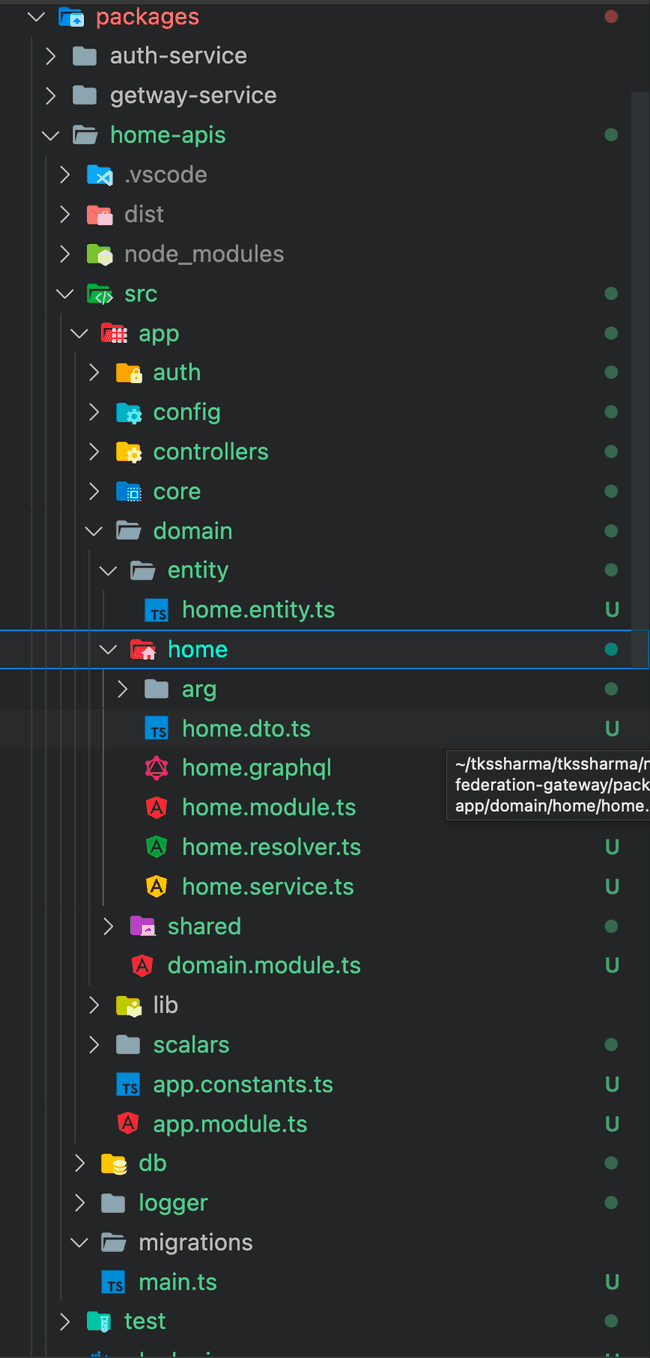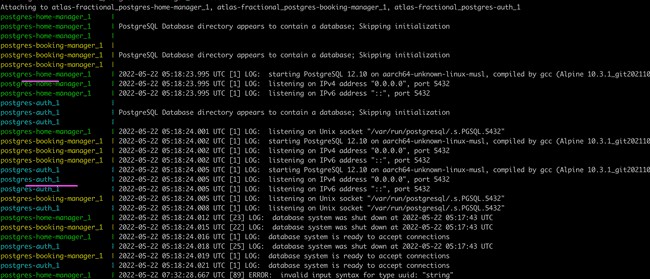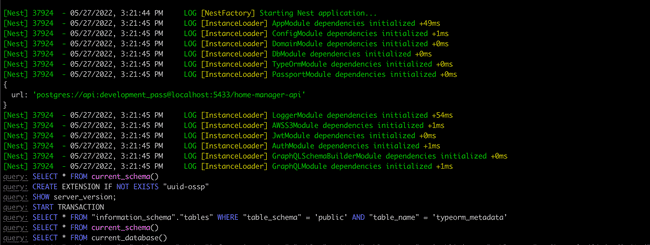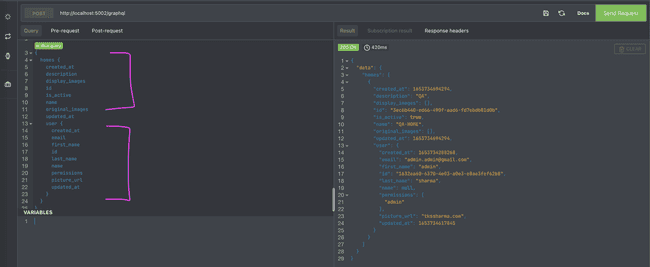Building Graphql Service (Home APIs) 🚀 🚀
You can check Part-1/2/3 of this Blog from here, In this example we will build another graphql service Home APIs
Github : https://github.com/tkssharma/nestjs-with-apollo-federation-gateway
- https://tkssharma.com/nestjs-with-apollo-federation-for-microservices-part-1
- https://tkssharma.com/nestjs-with-apollo-federation-for-microservices-part-2
- https://tkssharma.com/nestjs-with-apollo-federation-for-microservices-part-3
To understand the whole architecture we need to have
- gateway Nestjs service (Gateway-service)
- graphql User service (Microservice-1)
- graphql Home manager service (Microservice-2)
Overall we have one gateway and two microservice exposing graphql interface.
In this Post we are building Home Service and Most importantly we will see how gateway is composing all sub-graphs and fetching data together for us from different graphs
- The whole Objective of this series is how we can fetch Home APIs data with User Data, How gateway is composing both data together where data is here in different service databases
Lets Build Home APIs
Its lerna project and we have these 3 modules
- gateway nestjs module
- user auth api module
- home service api module
All graphql services using schema first approach that means first we will write schema and then we will write
- resolvers
- services
- modules
- root modules
Resolvers will map to the query and mutations we have and interact with services to fetch data Lets check folder structure
- We are building simple home crud APIs, Lets create basic things
- Home Graphql Schema
- Home Module
- Home Service
- Home Entity
- Home DTO
- Home Resolver
Home Entity
import { Entity, PrimaryGeneratedColumn, Column, BaseEntity, ManyToOne, CreateDateColumn, DeleteDateColumn, UpdateDateColumn, OneToOne, JoinColumn, OneToMany } from 'typeorm';
@Entity('homes')
export class Home extends BaseEntity {
@PrimaryGeneratedColumn('uuid')
public id!: string;
@Column('varchar', { length: 500, unique: true })
public name!: string;
@Column({ type: 'uuid' })
public user_id!: string;
@Column('varchar')
public description!: string;
@Column({ type: 'jsonb', default: [] })
public display_images!: string[];
@Column({ type: 'jsonb', default: [] })
public original_images!: string[];
@Column({ type: 'jsonb', default: null })
public metadata!: any;
@Column({ type: 'boolean', default: true, select: true })
public is_active!: boolean;
@CreateDateColumn({ type: 'timestamptz', default: () => 'CURRENT_TIMESTAMP' })
public created_at!: Date;
@UpdateDateColumn({ type: 'timestamptz', default: () => 'CURRENT_TIMESTAMP' })
public updated_at!: Date;
@DeleteDateColumn()
public deleted_at?: Date | null;
}Home Graphql Schema
scalar Date
scalar Upload
type Home @key (fields: "id"){
id: ID!
name: String!
user: User
description: String!
display_images: [String!]
original_images: [String!]
is_active: Boolean!
created_at: Date
updated_at: Date
}
extend type User @key(fields: "id") {
id: ID! @external
}
type Query {
homes: [Home!]
home(id: ID): Home!
findHomes(name: String!): [Home!]
activeHomes: [Home!]
}
input HomeInput {
name: String!
description: String!
is_active: Boolean!
}
type Mutation {
createHome(payload: HomeInput!): Home
updateHome(id: ID!, payload: HomeInput!): Home
}Lets take a close look here We have home Schema and we are extending User Type here from other service
type Home @key (fields: "id"){
id: ID!
name: String!
user: User
description: String!
display_images: [String!]
original_images: [String!]
is_active: Boolean!
created_at: Date
updated_at: Date
}
extend type User @key(fields: "id") {
id: ID! @external
}Lets add resolver which should be simple data fetch from services
import { AdminGuard } from '@app/auth/guards/admin.guard';
import { JwtAuthGuard } from '@app/auth/guards/jwt-auth.guard';
import { Logger } from '@logger/logger';
import { ConsoleLogger, UseGuards } from '@nestjs/common';
import { Resolver, Query, Args, Mutation, Parent, ResolveField, Context, ResolveReference } from '@nestjs/graphql';
import { FileUpload, GraphQLUpload } from 'graphql-upload';
import { HomeLocality } from '../entity/home-locality.entity';
import { Home } from '../entity/home.entity';
import { HomeService } from './home.service';
@Resolver((of: any) => Home)
export class HomeResolver {
constructor(private homeService: HomeService,
private readonly logger: Logger) {
}
@Query()
@UseGuards(JwtAuthGuard, AdminGuard)
async homes() {
return await this.homeService.listAll();
}
@Query()
@UseGuards(JwtAuthGuard, AdminGuard)
async findHomes(@Args('name') name: string) {
return await this.homeService.findHome(name);
}
@Query()
@UseGuards(JwtAuthGuard, AdminGuard)
async activeHomes() {
return await this.homeService.listAllActiveHomes();
}
@Query()
async home(@Args('id') id: string) {
return await this.homeService.getById(id);
}
@Mutation()
@UseGuards(JwtAuthGuard, AdminGuard)
async createHome(@Args() args: any, @Context() context: any) {
const { userid } = context.req.headers;
return await this.homeService.createHome(args, userid);
}
@Mutation()
@UseGuards(JwtAuthGuard, AdminGuard)
async updateHome(@Args('id') id: string, @Args() args: any) {
return await this.homeService.updateHome(id, args);
}
@ResolveField('user')
user(@Parent() home: Home) {
this.logger.http("ResolveField::user::HomeResolver" + home.user_id)
return { __typename: 'User', id: home.user_id };
}
@ResolveReference()
async resolveReference(reference: { __typename: string; id: string }) {
this.logger.http('Logging :: ResolveReference :: home')
return await this.homeService.getByHomeId(reference.id);
}
}Everything is simple here except two methods which you see in the last of the resolvers
and they are the one responsible for fetching data cross services
ResolveField, ResolveReference
ResolveReference - means when any other services need Home data based on ID this method graphql gateway will invoke
ResolveField - this is reference so when in home graphql if i want to get data of User then i have to resolve that data from another service @ResolveField('user') this will ask gateway to resolve User by passing { __typename: 'User', id: home.user_id } this to the gateway, Now gateway will check who can give me this User Type for this id as userId
Notes -- Very very Important [keep TypeORM entity class name same as Graphql Types such as User and Home]
@ResolveField('user')
user(@Parent() home: Home) {
this.logger.http("ResolveField::user::HomeResolver" + home.user_id)
return { __typename: 'User', id: home.user_id };
}
@ResolveReference()
async resolveReference(reference: { __typename: string; id: string }) {
this.logger.http('Logging :: ResolveReference :: home')
return await this.homeService.getByHomeId(reference.id);
}You can also access the context if its has ben set already
async createHome(@Args() args: any, @Context() context: any) {
const { userid } = context.req.headers;
return await this.homeService.createHome(args, userid);
}Now service is just using TypeORM Repo to fetch data for Us
import { Logger } from '@logger/logger';
import { Injectable } from '@nestjs/common';
import { InjectRepository } from '@nestjs/typeorm';
import { ILike, Like, Repository } from 'typeorm';
import { HomeFacility } from '../entity/home-facility.entity';
import { HomeLocality } from '../entity/home-locality.entity';
import { Home } from '../entity/home.entity';
import { CreateHomeDto } from './home.dto';
@Injectable()
export class HomeService {
constructor(
@InjectRepository(Home) private readonly homeRepository: Repository<Home>,
@InjectRepository(HomeLocality) private readonly homeLocalityRepository: Repository<HomeLocality>,
private readonly logger: Logger
) {
}
async createHome(data: any, userid: string): Promise<Home> {
const body = data.payload;
try {
const existingHome = await this.homeRepository.findOne({ where: { name: body.name } })
if (existingHome) {
return existingHome;
}
const res = await this.homeRepository
.save({ ...body, user_id: userid });
return res;
} catch (err: any) {
this.logger.error(err);
throw err;
}
}
async updateHome(id: string, data: any): Promise<Home> {
const body = data.payload;
const homeHome = await this.homeRepository.findOne({ where: { id } });
const updatedHome = { ...homeHome, ...body }
return await this.homeRepository.save(updatedHome)
}
async listAll() {
return await this.homeRepository.find({ relations: ['locality', 'facilities'] });
}
async findHome(name: string) {
return await this.homeRepository.find({ where: { name: ILike(`%${name}%`) }, relations: ['locality', 'facilities'] });
}
async listAllActiveHomes() {
return await this.homeRepository.find({ where: { is_active: true }, relations: ['locality', 'facilities'] });
}
async getById(id: string) {
return await this.homeRepository.findOne({ where: { id, is_active: true }, relations: ['locality', 'facilities'] });
}
async getByHomeName(name: string) {
return await this.homeRepository.findOne({ where: { name } });
}
async getByHomeId(id: string) {
return await this.homeRepository.findOne({ where: { id } });
}
}Finally our Domain Module
import { MiddlewareConsumer, Module } from '@nestjs/common';
import { TypeOrmModule, TypeOrmModuleAsyncOptions } from '@nestjs/typeorm';
import { GraphQLModule } from '@nestjs/graphql';
import { join } from 'path';
import { ConfigModule } from '@app/config/config.module';
import { DbModule } from '../../db/db.module';
import { Home } from './entity/home.entity';
import { HomeModule } from './home/home.module';
import { LoggerModule } from '@logger/logger.module';
import { Upload } from '../Scalars/upload.scalar';
import { ApolloFederationDriver, ApolloFederationDriverConfig } from '@nestjs/apollo';
import { GraphQLError, GraphQLFormattedError } from 'graphql';
@Module({
imports: [
DbModule.forRoot({
entities: [Home],
}),
LoggerModule,
HomeModule,
ConfigModule,
GraphQLModule.forRoot({
typePaths: ['./**/*.graphql'],
uploads: false,
driver: ApolloFederationDriver,
context: ({ req }: any) => ({ req }),
formatError: (error: GraphQLError) => {
console.log(error);
const graphQLFormattedError: GraphQLFormattedError = {
message: error?.extensions?.exception?.response?.message || error?.message,
};
return graphQLFormattedError;
},
}),
],
})
export class DomainModule {}This module also using ApolloFederationDriver so these services can use schema from other services
From the whole code the real magic is happening in schema
extend type User @key(fields: "id") {
id: ID! @external
}All these @key, @provided , @external is provided in apollo specs
@key
directive @key(fields: _FieldSet!) repeatable on OBJECT | INTERFACEThe @key directive is used to indicate a combination of fields that can be used to uniquely identify and fetch an object or interface.
type Product @key(fields: "upc") {
upc: UPC!
name: String
}Multiple keys can be defined on a single object type:
@provides
directive @provides(fields: _FieldSet!) on FIELD_DEFINITION The @provides directive is used to annotate the expected returned fieldset from a field on a base type that is guaranteed to be selectable by the gateway. Given the following example:
type Review @key(fields: "id") {
product: Product @provides(fields: "name")
}
extend type Product @key(fields: "upc") {
upc: String @external
name: String @external
}When fetching Review.product from the Reviews service, it is possible to request the name with the expectation that the Reviews service can provide it when going from review to product. Product.name is an external field on an external type which is why the local type extension of Product and annotation of name is required.
@requires
directive @requires(fields: _FieldSet!) on FIELD_DEFINITION The @requires directive is used to annotate the required input fieldset from a base type for a resolver. It is used to develop a query plan where the required fields may not be needed by the client, but the service may need additional information from other services. For example:
# extended from the Users service
extend type User @key(fields: "id") {
id: ID! @external
email: String @external
reviews: [Review] @requires(fields: "email")
}In this case, the Reviews service adds new capabilities to the User type by providing a list of reviews related to a user. In order to fetch these reviews, the Reviews service needs to know the email of the User from the Users service in order to look up the reviews. This means the reviews field / resolver requires the email field from the base User type.
@external
directive @external on FIELD_DEFINITION The @external directive is used to mark a field as owned by another service. This allows service A to use fields from service B while also knowing at runtime the types of that field. For example:
# extended from the Users service
extend type User @key(fields: "email") {
email: String @external
reviews: [Review]
}lets See this in action
- we need docker-compose up so we can have all database available for TypeORM
docker-compose upwill crate container- install package dependencies in all projects
- run applications and final run gateway
Setting up the whole platform Locally
This platform contains all these components
- User Management service
- Home Manager service
- Gateway Service
- Home Manager Service
Running all these services
- we are using docker-compose to bootstrap all container only (database containers) in the root of the project run
docker-compose up- check the longs and make sure databases has been created
git clone <repo>
cd nestjs-with-apollo-federation-gateway
cd packagesRunning Auth service
cd auth-service
vi .envupdate env with this content
DATABASE_URL= postgres://api:development_pass@localhost:5431/auth-api
SENDGRID_API_KEY=SSSS
SENDGRID_VERIFIED_SENDER_EMAIL=ssss@gmail.com
DEBUG="ssss:*"
LOG_LEVEL=http
PORT=5006
NODE_ENV=local
JWT_SECRET=HELLO
JWT_EXPIRE_IN=3600*24Now run application in watch mode it will be live on localhost:5006
npm run start:devRunning Home Manager
cd home-manager
vi .envupdate env with this content
NODE_ENV=local
LOG_LEVEL=http
PORT=5003
SECRET_KEY=HELLO
NEW_RELIC_KEY=
DATABASE_URL=postgres://api:development_pass@localhost:5433/home-manager-apiNow run application in watch mode it will be live on localhost:5003
npm run start:devFor Gateway also trigger same command npm run start:dev
Now lets test our application Our Gateway is connected to both sub-graphq apis running on different ports We have to make sure both service are running before running gateway service
{ name: 'User', url: 'http://localhost:5006/graphql' },
{ name: 'Home', url: 'http://localhost:5003/graphql' },If you are using same PORT and env then Gateway will run on http://localhost:5002/graphql
Conclusion
I hope this series is useful for devs who are looking for setting up Nest JS graphql gateway with federation support Important Pats and challenging tasks Notes ::
-
getting all dependencies working with each other (migration is a real pain)
-
TypeORM migration will create entities as we start application
-
https://github.com/tkssharma/nestjs-with-apollo-federation-gateway clone this repo and play with this
-
https://tkssharma.com/nestjs-with-apollo-federation-for-microservices-part-2
-
https://tkssharma.com/nestjs-with-apollo-federation-for-microservices-part-3
-
https://tkssharma.com/nestjs-with-apollo-federation-for-microservices-part-4
References
- https://www.apollographql.com/docs/federation/federation-spec/#key
- https://www.apollographql.com/docs/federation
- https://www.apollographql.com/docs/federation/
- https://www.apollographql.com/docs/federation/federation-2/new-in-federation-2
- https://github.com/apollographql/supergraph-demo-fed2
- https://www.apollographql.com/docs/federation/federation-spec/
- https://docs.nestjs.com/graphql/migration-guide
- https://docs.nestjs.com/graphql/federation





Comments